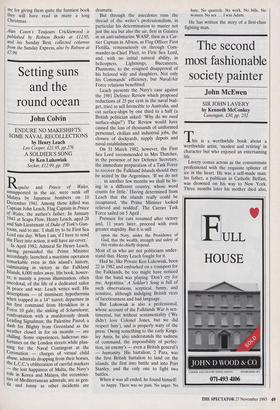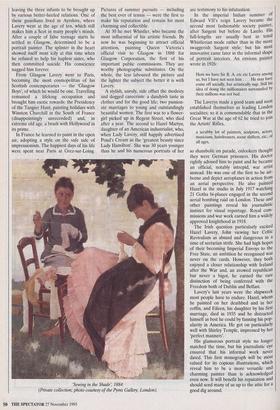The second most fashionable society painter
John McEwen
SIR JOHN LAVERY by Kenneth McConkey Canongate, 130, pp. 232 This is a worthwhile book about a worthwhile artist, 'modest and retiring' in character but who enjoyed an entertaining life.
Lavery comes across as the consummate professional with the requisite splinter of ice in the heart. He was a self-made man; his father, a publican in Catholic Belfast, was drowned on his way to New York. Three months later his mother died also, leaving the three infants to be brought up by various better-heeled relations. One of these guardians lived in Ayrshire, where Lavery went at the age of ten, which still makes him a Scot in many people's minds. After a couple of false teenage starts he settled in Glasgow, determined to be a portrait painter. The splinter in the heart showed itself most icily at this time when he refused to help his hapless sister, who then committed suicide. His conscience nagged him forever.
From Glasgow Lavery went to Paris, becoming the most cosmopolitan of his Scottish contemporaries — the 'Glasgow Boys', of which he would be one. Travelling remained a lifelong occupation and brought him exotic rewards: the Presidency of the Tangier Hunt, painting holidays with Winston Churchill in the South of France (disappointingly unrecorded) and, in extreme old age, a brush with Hollywood in its prime.
In France he learned to paint in the open air, adopting a style on the safe side of impressionism. The happiest days of his life were spent near Paris at Grez-sur-Loing. Pictures of summer pursuits — including the best ever of tennis — were the first to make his reputation and remain his most charming and collectible.
At 30 he met Whistler, who became the most influential of his artistic friends. By now he was beginning to attract official attention, painting Queen Victoria's official visit to Glasgow in 1888 for Glasgow Corporation, the first of his important public commissions, They are worthy photographic substitutes. On the whole, the less laboured the picture and the lighter the subject the better it is with Lavery.
A stylish, unruly, side offset the modesty and dogged careerism: a dandyish taste in clothes and for the good life; two passion- ate marriages to young and outstandingly beautiful women. The first was to a flower- girl picked up in Regent Street, who died after a year. The second to Hazel Martyn, daughter of an American industrialist, who, when Lady Lavery, still happily advertised Pond's Cream as the 'greatest beauty since Lady Hamilton'. She was 30 years younger than he and his numerous portraits of her `Sewing in the Shade, 1884.
(Private collection; photo courtesy of the Pyms Gallery, London). are testimony to his infatuation. In the imperial Indian summer of Edward `VI's reign Lavery became the second most fashionable society painter, after Sargent but before de Laszlo. His full-lengths are usually best in tonal Whistlerian mode rather than in the more swaggerish Sargent style; but his most innovative came later in the informal shape of portrait interiors. An envious painter wrote in 1926: Here we have Sir R. A. etc etc Lavery among us, but I have not seen him . . He may have come off socially, but artistically nup. Still his idea of doing the millionaires surrounded by their millions was not bad.
The Laverys made a good team and soon established themselves as leading London socialites; so it is commendable that in the Great War at the age of 62 he tried to join the Artists' Rifles, a scrubby lot of painters, sculptors, actors, musicians, hairdressers, scene shifters, etc., of all ages, so shambolic on parade, onlookers thought they were German prisoners. His doctor rightly advised him to paint and he became an official, notably intrepid, war artist instead. He was one of the first to be air- borne and depict aeroplanes in action from an aerial perspective. He also painted Hazel in the studio in July 1917 watching 21 Gotha bi-planes engaged in the second aerial bombing raid on London. These and other paintings reveal his journalistic instinct for visual reportage. Royal com- missions and war work earned him a widely approved knighthood in 1918. The Irish question particularly excited Hazel Lavery, John viewing her Celtic Revivalism as absurd and dangerous in a time of sectarian strife. She had high hopes of their becoming Imperial Envoys to the Free State, an ambition he recognised was never on the cards. However, they both enjoyed a closer relationship with Ireland after the War and, an avowed republican but never a bigot, he earned the rare distinction of being conferred with the Freedom both of Dublin and Belfast.
Lavely's last years were the shipwreck most people have to endure. Hazel, whom he painted on her deathbed and in her coffin, and Eileen, his daughter by his first marriage, died in 1935 and he distracted himself as best he could by fanning his pop- ularity in America. He got on particularly well with Shirley Temple, impressed by her `perfect manners'.
His glamorous portrait style no longer matched the time, but his journalistic eye ensured that his informal work never dated. This first monograph will be most valued for its copious illustrations, which reveal him to be a more versatile and charming painter than is acknowledged even now. It will benefit his reputation and should send many of us up to the attic for a good dig around.











































































 Previous page
Previous page